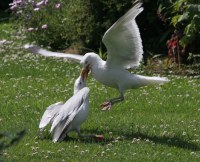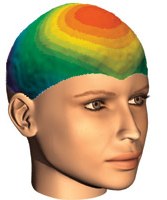Adam Bjork and Scott Pitnick of Syracuse University have found a sexy paradox. But, don’t get too excited, it’s fruit fly sex we’re talking here and specifically sperm and egg production in Drosophila.
Previous work in the Pitnick lab showed that after sex, sperm competition takes place within the females (who mate with several males) can lead to decreased sperm quantities by favouring the production of larger sperm. In other words, never mind the quantity feel the length mode comes into play, because female fruit flies have evolved so that longer sperm have a greater chance of successfully fertilizing eggs. Fertilization failure is obviously important as individuals who fail are essentially an evolutionary dead end.
This leads to the ‘big sperm paradox’ because the idea that postcopulatory sexual selection could favour the evolution of giant sperm clashes with traditional sexual selection theory, which predicts that the most successful sperm competitors will be the males that produce many, tiny sperm. As males evolve to produce larger – and therefore fewer – sperm, eggs become less rare, and sexual selection should weaken, according to theory. The term ‘isogamy’ refers to the state at which males and females have equal investment per gamete (sex cell) when producing sperm and eggs. In a truly isogamous population, each sperm and each egg would have a chance to participate in a successful fertilization. In such a population, sexual selection would be extremely weak, as there would be little or no competition among males to fertilize eggs.
To investigate this apparent paradox between empirical data and traditional theory, Bjork and Pitnick set out to measure the strength of sexual selection in four Drosophila species of varying sperm length, ranging from the anisogamous D. melanogaster (in which a male produces 30 sperm in the time it takes a female to make one egg) to the nearly isogamous D. bifurca (where just six sperm are produced per egg). They found that, contrary to theoretical predictions, the level of competition among males did not decrease; the strength of sexual selection remained high as sperm size increased. Their results show that, once females evolve a preference for longer sperm, intense sperm competition can actually reverse the trajectory of sperm evolution so that the most successful males are those with the most female-like strategy of producing very few, large gametes.’The sperm of Drosophila bifurca is 20 times longer than the male that produces it,’ says Bjork.
‘To put that into perspective, if humans made sperm that long and you took a six-foot man and stood him on the goal line of a football field, his sperm would stretch out to the 40-yard line.’
While it is fascinating, the evolution of giant sperm is puzzling. Says Bjork: ‘Until recently, it was widely believed that selection generated by sperm competition favors males that manufacture the smallest gametes possible in order to maximize sperm number. In essence, sperm competition is attributed with the evolutionary maintenance of anisogamy. I became interested in understanding whether the very act of sexual selection, by definition, can limit its own ability to act.’
The next step is to investigate the details of the effects of sperm length evolution on the intensity of sexual selection.
Details were published in Nature under the banner “Intensity of sexual selection along the anisogamy—isogamy continuum”, which doesn’t give much away unless you’re in the field. The paper’s DOI reference number is 10.1038/nature04683. Use our DOI lookup tool to go straight to it (simply cut and paste the DOI and click DOI lookup in the right-hand toolbox) and don’t forget you can grab the simple script to add this and our other toolboxes to your website.



